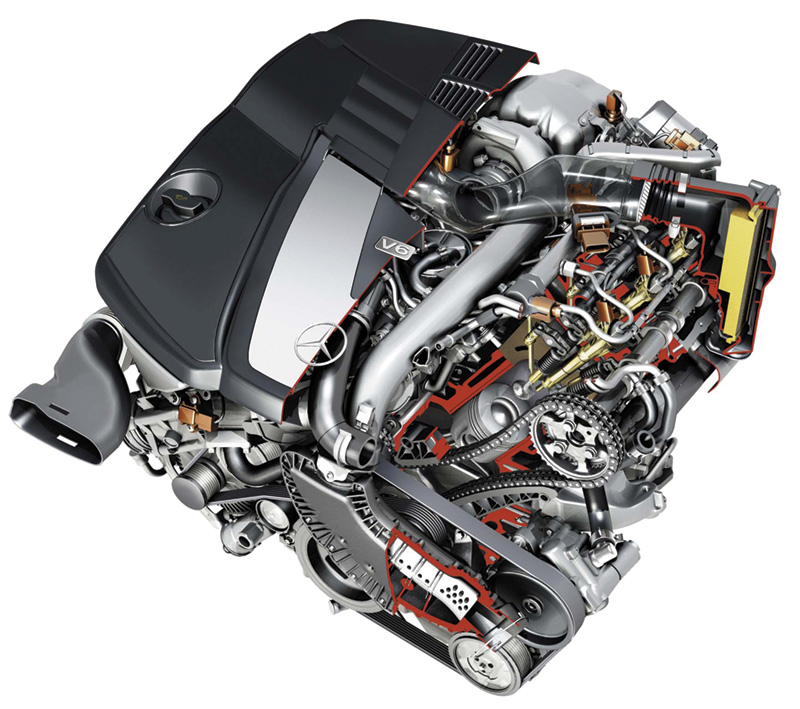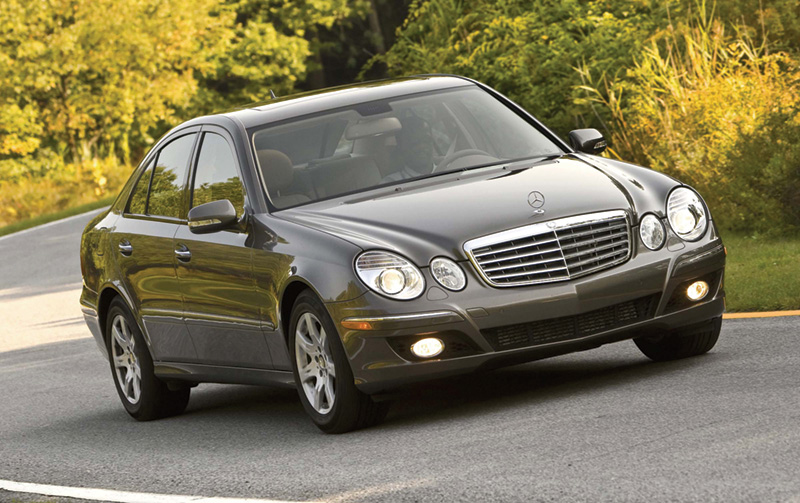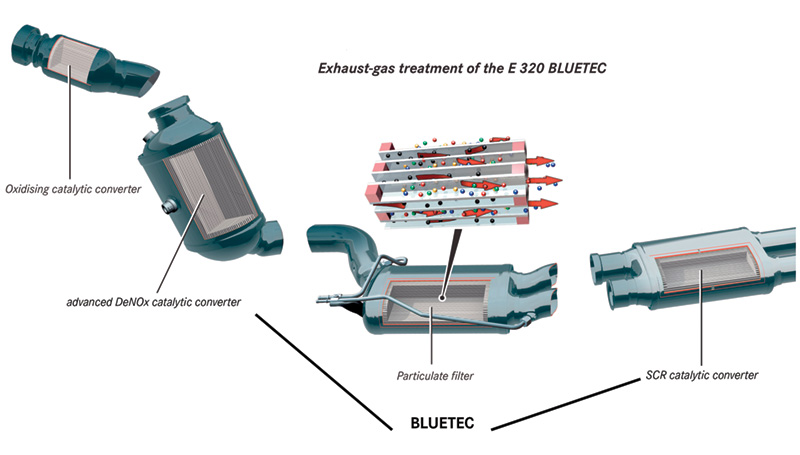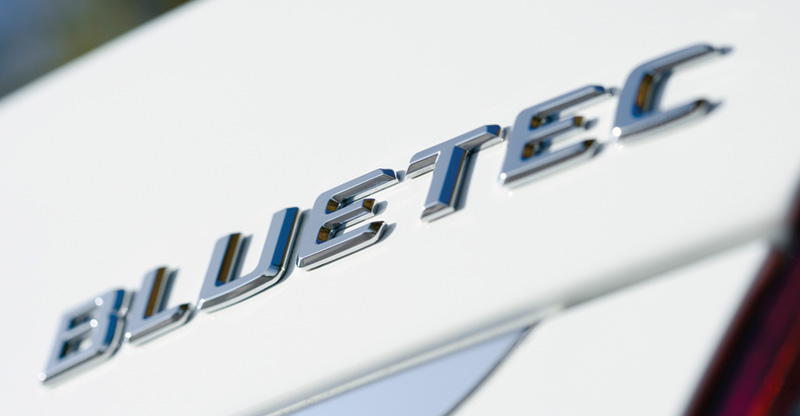Diesel redux, thanks to intelligent engineering
Mercedes-Benz is leading automobile manufacturers in the re-introduction of diesel passenger vehicles to North America. First, the E320 CDI (W211) debuted in June, 2005 powered by the OM 648, an inline six-cylinder common-rail diesel equipped with a Diesel Oxidation Catalyst. In Model Year 2007, the OM 648 was replaced by the OM 642 V6, which first appeared in the E320 BLUETEC. This engine does not use the additive AdBlue®, but does use a Diesel Oxidation Catalyst, NOx Storage Catalyst, Diesel Particulate Filter (DPF) and a Selective Catalytic Reduction Catalyst (SCR). This is known as the Bin 8 diesel.
The OM 642 was also available in the GL, M- and R-Classes, but is not a BLUETEC as it is in the E-Class. This is a BIN 10 diesel. The vehicles were badged as 320 CDI, and have a DOC and DPF, but no SCR. They also require Ultra Low Sulfur fuel.
Cleaning up diesel emissions requires adopting a number of overlapping approaches. Extremely high levels of EGR combined with a reduced compression ratio curtails the production of N0x. A “regular†oxidizing catalyst combusts remaining hydrocarbons. A particulate filter traps soot. For Tier 2 Bin 5 vehicles, an SCR catalyst, combined with urea injection on the 2009 models, transforms oxides of nitrogen into elemental nitrogen and water. How does all this work, and what are the implications for the Independent Mercedes-Benz repair facility?
Exhaust Gas Recirculation
Let’s begin with EGR. Since EGR gases are oxygen poor, they’re inert when it comes to combustion. Inert gas, by displacing the oxygen-rich air-fuel charge, keeps peak combustion temperatures down. This reduces the formation of NOx. Intercooling EGR gases makes them even more effective in controlling N0x production, especially when EGR flow rates of 30-50% are used.
As with gasoline engines, EGR gases tend to leave carbon deposits on everything they come into contact with. Cooling EGR aggravates the problem since it tends to precipitate out acidic compounds, which would otherwise remain in gaseous form. Mercedes-Benz’s response is to use a corrosion-resistant stainless steel intercooler. Intercooling creates the additional issue of contributing to the total heat load a diesel engine must dissipate. Consequently, cleaning EGR passages, valves, and maintaining the optimum performance of cooling systems are likely to be important services for Independent Mercedes-Benz repair facilities.
The second issue associated with EGR and diesels is convincing EGR to flow into the intake manifold. There’s little or no manifold vacuum to coax EGR gas out of the exhaust and into the intake. The solution Mercedes-Benz adopted is adding an ECM-controlled electric throttle in order to create manifold vacuum on demand. Intake manifolds exposed to high levels of EGR can be expected to foul, and cleaning may be occasionally required to keep these diesels at optimum performance – and prevent throttle valve actuators from sticking.
The new V6 is equipped with an EGR valve with a lift sensor, EGR intercooler, mass air flow sensor and throttle valve actuator. The cooled EGR gases are introduced after the throttle valve actuator. When EGR is active, the ECM knows the quantity of EGR entering the engine by the amount of lift measured by the sensor, and also knows how much fresh air is entering the engine from the mass air flow sensor. This helps in calculating the amount of fuel to be injected.
To determine DPF regeneration, the amount of backpressure before and after the DPF is measured by the differential pressure sensor. Regeneration can be spontaneous (if temperatures in the DPF reach burn-off), or triggered by the diesel ECM. Problems can arise if the vehicle is not driven for a sufficient amount of time to complete a successful regeneration. If this occurs several times, the DPF can be overloaded and the MIL will trigger. Using SDS, the technician can force regeneration to occur during a test drive.
Two variants of the BLUETEC technology were initially developed: the NAC+SCR system, which met Euro IV emissions standards and was good enough for 45 of the 50 US States (Tier 2 Bin 8), and the AdBlue® system, with urea injection (see sidebar). AdBlue® cars will be introduced in the 2009 model year and meet emissions requirements in all 50 states (Tier 2 Bin 5). Both technologies demand the use of Ultra-Low Sulfur Diesel (ULSD) fuel, which became the standard at American pumps in 2005-2006.
In both systems, exhaust leaves the engine and passes through a Diesel Oxidation Catalyst (DOC), which “combusts†carbon monoxide and unburned hydrocarbons. Next is the NOx Absorber Catalyst, or NAC, which removes and traps oxides of nitrogen. During periods of lean operation, NOx is stored; under richer operating conditions (which can be created by manipulating the fuel injection) the NAC undergoes a regeneration process and releases a small amount of ammonia into the exhaust. The ammonia is stored downstream in the Selective Catalytic Reduction (SCR) catalyst, which uses it to further reduce NOx. Mercedes-Benz engineers had hoped to achieve 50-state emissions with NAC+SCR, however, barely missed. Hence, AdBlue®.
Oxidizing catalysts are nothing new, and should pose little or no service challenge for techs. Not so a diesel particulate filter (DPF). When sufficient particulate matter has accumulated in the DPF, and an increase in back pressure is detected, regeneration is called for. Regeneration involves boosting the temperature of the exhaust to the point where soot accumulated in the DPF gets incinerated into ash. Think of it as a self-cleaning oven.
Exhaust temperatures are boosted by injection of additional fuel into the cylinders. The oxidizing catalyst will turn this overly-rich mixture into the extremely hot exhaust flow needed to regenerate the DPF. Ideally, regeneration should occur while driving at highway speeds so there is plenty of airflow around the DOC and DPF. That means little or no risk of igniting shrubbery or brush beneath the vehicle, nor of causing customer concerns. Regeneration should be totally transparent to the driver. However, a boosted idle speed or other alteration of engine “feel†may occur, causing driver concerns. Any sort of fuel or oil leak, such as a sticking injector or failed turbo seal could have extremely serious consequences at regeneration time. If a fuel injector is questionable, it should be replaced.
In order to detect backpressure across the DPF, measure temperatures, and inject urea into the SCR, pressure sensors and other items will have to be located directly in the exhaust stream, a necessarily hostile environment. Logically, these sensors should fail at about the same rate as oxygen sensors and DPF sensors on gasoline engines, and should trigger similar codes allowing ease of diagnosis.
Other BLUETEC issues independent repair shops may have to deal with include the use, or misuse, of biodiesel fuels. According to MBUSA, B5 biodiesel is approved for CDI diesel without affecting the warranty. Biodiesel must adhere to ASTM D6751 and in addition have the necessary oxidation stability to prevent damage from deposits or corrosion. Whether or not all B5 biodiesel available at the pump meets these requirements is unclear, and this situation may confuse owners. A related requirement is the use of engine oil meeting American Petroleum Institute (API) rating CJ-4 to prevent ash from plugging the particulate trap.
Instant Start System
BLUETEC diesels incorporate an Instant Start System (ISS) with glow plugs that can reach operating temperatures in two seconds or less. At temperatures above five deg. F. no waiting is required before the engine can be cranked. The glow plugs are controlled by a module which may utilize them not only in starting situations, but whenever their use could stabilize combustion, such as in extended idling in extremely cold weather. For example, what’s known as “post-glowing†will keep the glow plugs heated for a brief period after engine startup to achieve smoother operation and reduce emissions. A module, which communicates with the ECM, controls the current applied to each glow plug, and incorporates fail-safe features, such as short circuit detection.
The New V6
The 2007-2008 E320 BLUETEC boasts acceleration comparable to the gas-engined E350 six-cylinder a result of the diesel’s whopping 388 lb. ft. of torque (as compared to 258 in the gas models). That figure is only three lb. ft. short of the E550 V8. It is a completely different engine from what’s found in the 2006 E320 CDI, which sported an inline six.
The new 3.0-litre V6 diesel features four valves per cylinder. It is built on an aluminum block with cast-in steel cylinders, with an 83 mm bore and “undersquare†92 mm stroke. A balance shaft located between the cylinder banks counter-rotates at the same speed as the crankshaft to smooth the V-6 out. Twin overhead camshafts in each cylinder bank operate the intake and exhaust valves, with the intake cams driven by a double chain that also drives the balance shaft. A gear on each intake cam, in turn, drives the exhaust cams.
Mercedes-Benz engineers found that throttling one of the two diesel intake ports on each cylinder at light loads added slight turbulence that helped optimize the combustion process and further reduce fuel consumption and exhaust emissions.
While many diesel engines have compression ratios higher than 20:1, Mercedes-Benz engineers found with the Garrett GT20V variable-geometry turbocharger, the engine is more efficient and produces less emissions utilizing a compression ratio of 16.5:1 (boost goes up to 29psi). The turbo uses a VNT (Variable Nozzle Turbine). The engine’s electronics control the VNT’s vanes to suit the load. The intake charge passes through an air-to-air intercooler lowering the air temperature by up to 150 deg. F. for increased charge density.
The E320 BLUETEC uses the latest version of the Mercedes-Benz Common Rail Direct Injection (CDI) system, which keeps the fuel pressure at up to 23,000 psi. The BLUETEC V6 is fitted with piezoelectric injectors that work significantly faster than magnetic solenoid-based injectors, allowing up to five injection events per combustion event. So called “Pilot Injection†events reduce the noise (clatter) associated with diesels by slowing the rapid increase in pressure and temperature associated with a single injection event.
Impressions
So much for emissions, what about performance? As numerous automotive writers have commented, “This ain’t your daddy’s diesel.†The gut-wrenching torque the new diesels are able to provide at low rpm make them as much of a performance option as an economy option in the minds of many. Turbocharging makes the new diesel engine just as fuel efficient as the full size hybrids offered by other manufacturers, especially during highway travel. Who would ever have used “diesel†in the same sentence as “sportâ€, or “luxuryâ€? Tire-burning torque, great fuel mileage, lack of smoke — will owners even be able to tell this is a diesel?
The answer is yes. On a cold morning, there will still be enough clatter to tell that this is a diesel engine. Windows shut, drivers will seldom pause to think, “I’m driving a diesel.†As with all turbocharged engines, there may still be slight lag between stabbing the pedal and the vehicle launching. But according to many who have driven these cars, the “diesel disadvantages†have been minimized to the point where they are inconsequential – and more than made up for by the tremendous fuel economy these full size vehicles can deliver, as much as 36 mpg, highway.
Perhaps one of the most compelling arguments for “going diesel†with Mercedes-Benz is that unlike domestic manufacturers who were required to re-tool and build completely new engines and emissions systems in order to meet 50-state requirements, Mercedes-Benz’s BLUETEC technology, including AdBlue®, is already in use in tens of thousands of commercial trucks in Europe. As a result, American consumers are not being asked to be guinea pigs for testing new emissions technologies – as the owners of some domestic diesel trucks appear to have been.
AdBlue®: What is it?
AdBlue® is the brand name for the Mercedes-Benz flavor of urea injection. Ammonia (NH3) created by the injection of liquid urea into the hot exhaust stream combines with NO and NOx to produce H2O and N2 – harmless water and elemental nitrogen (N2 makes up approximately 78% of the earth’s atmosphere). Urea injection allows manufacturers to “virtually eliminate†all NOx produced by internal combustion engines.
The AdBlue® system places the diesel oxidation catalyst and particulate filter in a single “can.†Ammonia is supplied by injecting a concentrated urea solution also called AdBlue® upstream of the SCR catalyst. The addition of ammonia enables the SCR catalyst to reduce NOx emissions to a level even lower than the NAC-SCR system. AdBlue® is carried in a heated on-board tank, which should be replenished whenever the car is serviced.
A gallon of AdBlue® fluid should last approximately 2,500 miles. Should a sensor detect a low level, a dash warning light will be illuminated, and other consequences may be added to the program. The EPA doesn’t want diesel owners failing to refill it. The AdBlue® tank utilizes a special coupler that mates with the refill bottle, thus preventing filling errors.
BLUETEC is a Brand
A consortium of Mercedes-Benz, BMW, Daimler-Chrysler, and Volkswagen initially collaborated to create emissions control technologies for diesel engines in order to meet ever-tightening particulate and NOx standards, both in Europe and in North America. “BLUETEC†was the result. Of the original consortium members, Mercedes-Benz is the only manufacturer putting the BLUETEC badge on its vehicles equipped with this technology.











0 Comments